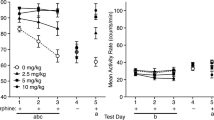Summary
Intraventricular infusion of the stable substance P analogue, DiMethyl-C7, was found to produce aversion in a place conditioning paradigm. This effect was independent of state dependent learning since the place aversion was also seen when the subjects were tested under the influence of the drug. A role for substance P in aversion is discussed.
Similar content being viewed by others
References
Armstrong DM, Pickel VM, Reis DJ (1982) Electron microscopic immunocytochemical localization of substance P in the area postrema of rat. Brain Res 243: 141–146
Bannon MJ, Elliott PJ, Alpert JE, Goedert M, Iversen SD, Iversen LL (1983) Role of endogenous substance P in stress-induced activation of mesocortical dopamine neurones. Nature 306: 791–792
Berman RF, Kesner RP (1976) Post-trial hippocampal, amygdaloid and lateral hypothalamic electrical stimulation effects on short and long-term memory of an appetitive experience. J Comp Physiol Psychol 90: 260–267
Eison AS, Iversen SD, Sandberg BEB, Watson SP, Hanley MR, Iversen LL (1982) Substance P analogue, DiMeC7: evidence for stability in the rat brain and prolonged central action. Science 215: 188–190
Elliott PJ (1986) A reliable, rapid and inexpensive method for producing and implanting chronic cannulae into brains of small animals. Pharmacol Biochem Behav 24: 1809–1811
Elliott PJ, Alpert JE, Bannon MJ, Iversen SD (1986) Selective activation of mesolimbic and mesocortical dopamine metabolism in rat brain by infusion of a stable substance P analogue into the ventral tegmental area. Brain Res 363: 145–147
Elliott PJ, Iversen SD (1986) Behavioural effects of tachykinins and related peptides. Brain Res 381: 68–76
Ettenberg A, Van Der Kooy D, Le Moal M, Koob GF, Bloom FE (1983) Can aversive properties of (peripherally-injected) vasopressin account for its putative role in memory? Behav Brain Res 7: 331–350
Fibiger HC, Phillips AG (1976) Retrograde amnesia after electrical stimulation of the substantia nigra: mediation by the dopaminergic nigro-neostriatal bundle. Brain Res 116: 23–33
Fitzsimmons JT, Evered MD (1978) Eledoisin, substance P and related peptides: intracranial dipsogens in the pigeon and antidipsogens in the rat. Brain Res 150: 533–542
Hong JS, Tilson HA, Yoshikawa K (1983) Effects of lithium and haloperidol administration on the rat brain levels of substance P. J Pharmacol Exp Therap 224: 590–593
Huston JP, Mueller CC, Mondadori C (1977) Memory facilitation by post-trial hypothalamic stimulation and other reinforcers: a central theory of reinforcement. Biobehav Res 1: 143–150
Huston JP, Staubli U (1978) Retrograde amnesia produced by post-trial injection of substance P into substantia nigra. Brain Res 159: 468–472
Huston JP, Staubli U (1979) Post-trial injection of substance P into lateral hypothalamus and amygdala, respectively facilitates and impairs learning. Behav Neural Biol 27: 244–248
Le Moal M, Koob GF, Koda LY, Bloom FE, Manning M, Sawyer WH, Rivier J (1981) Vasopressin receptor antagonist prevents behavioural effects of vasopressin. Nature 291: 491–493
Ljungdahl A, Hökfelt T, Nilsson G, Goldstein M (1978) Distribution of substance P-like immunoreactivity in the CNS of the rat. II. Light microscopic localization in relation to catecholamine containing neurones. Neuroscience 3: 861–944
Mucha RF, Van der Kooy D, O'Shaughnessy M, Bucenieks P (1982) Drug reinforcement studies by the use of place conditioning in rat. Brain Res 243: 91–105
Schlesinger K, Lipsitz DU, Peck PL, Pelleymounter M, Stewart JM, Chase TN (1983) Substance P enhancement of passive and active avoidance conditioning in mice. Pharmacol Biochem Behav 19: 655–661
Staubli U, Huston JP (1979) Differential effects on learning of ventromedial versus lateral hypothalamic post-trial injections of substance P. Pharmacol Biochem Behav 10: 783–786
Staubli U, Huston JP (1980) Facilitation of learning by post-trial injection of substance P into the medial septal nucleus. Behav Brain Res 1: 245–255
Swerdlow NR, Van der Kooy D, Koob GF, Wenger JR (1983) Cholecystokinin produces conditioned place aversions, not place-preferences, in food deprived rats: evidence against involvement in satiety. Life Sci 32: 2087–2093
Van der Kooy D (1984) Area postrema: site where cholecystokinin acts to decrease food intake. Brain Res 295: 345–347
Author information
Authors and Affiliations
Rights and permissions
About this article
Cite this article
Elliott, P.J. Place aversion induced by the substance P analogue, dimethyl-C7, is not state dependent: implication of substance P in aversion. Exp Brain Res 73, 354–356 (1988). https://doi.org/10.1007/BF00248227
Received:
Accepted:
Issue Date:
DOI: https://doi.org/10.1007/BF00248227




